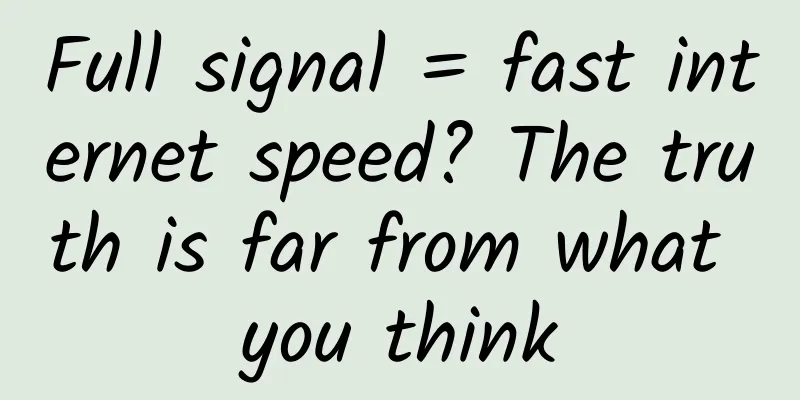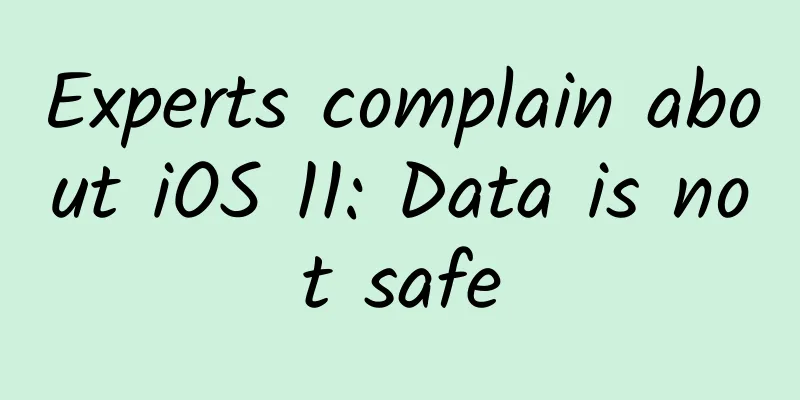Full signal = fast internet speed? The truth is far from what you think

|
In our daily lives, whether we are browsing our phones, making video calls, or sending a simple text message, there is an invisible "signal relay race" going on behind the scenes. Communication technology is like an unknown hero behind the scenes, delivering every message, every sound, and even every frame of video for us. However, many "legends" about communication are often misunderstood, such as "the stronger the signal, the faster the network speed" or "5G radiation is harmful to health." Today, let us unveil these misunderstandings, explore the mysterious world of signal transmission, and understand the true face of communication technology. Myth 1: Full signal = fast internet speed? The truth is far from that simple! Many people have this habit. When they see that the mobile phone signal bars are full, they confidently believe that the Internet speed will be very fast, and they can watch videos and send files in one go. But in fact, full signal bars and fast Internet speed are not completely equal. Let's take a look at what secrets are hidden behind "full signal bars". First of all, the number of signal bars shows the strength of the connection between the mobile phone and the base station, which is similar to how good your "friendship" with the base station is, but this is only part of the story. The network speed is like a "traffic feast" shared by many people. It depends not only on the signal strength, but also on many other factors. The congestion of the base station is one of the keys. Imagine that you go to a restaurant with your friends for dinner. The restaurant is crowded. Although you have a good relationship with the waiter, your food will still be late because too many people are ordering. Similarly, if the base station is overcrowded, even if the signal is full, you may face network "traffic jams" and the network speed will drop sharply. Secondly, the type of network is also crucial. Even if your 4G signal is full, its network speed cannot compete with 5G. Just like an old car with a full tank of gas, although it is powerful, it is ultimately not as fast as the new generation of supercars. Therefore, under the 4G network, even if the signal is strong, the network speed is still not as fast as 5G transmission. Finally, don't forget the interference of environmental factors. Whether it is high-rise buildings, electromagnetic waves, or wind, rain and lightning, they will affect the stability of the signal. Therefore, a full signal bar does not mean a fast network speed. If you want to truly enjoy the ultra-fast network, you also need to consider the combined effects of the base station load, network type and surrounding environment. A strong signal does not necessarily mean "fast"! Myth 2: Is 5G radiation harmful? Don’t worry, the truth is far more reliable than rumors! As 5G networks are fully rolled out, its "radiation hazards" seem to have become a hot topic. Some people believe that 5G poses a threat to human health and that this new technology has quietly invaded our lives. In fact, this concern has no scientific basis. Let's take a look at what 5G radiation is from a scientific perspective. First of all, the radio waves used by 5G are non-ionizing radiation, which is a type of electromagnetic wave with low energy. It does not have enough energy to interfere with or damage the DNA in human cells. In comparison, the "ionizing radiation" that everyone is familiar with, such as X-rays and gamma rays, is the type that really needs attention. Their energy is extremely high and can have adverse effects on health. But 5G is not a member of this "high-energy radiation team" at all. In fact, the amount of electromagnetic waves used by 5G networks is basically the same as that of 4G networks and Wi-Fi that we have been using for a long time. Before its official application, 5G technology has long passed the rigorous evaluation of many authoritative organizations such as the World Health Organization, and the conclusion is that it is safe. Therefore, the rumors about harmful 5G radiation, although scary, are actually just misunderstandings without scientific support. You can use 5G devices with confidence and enjoy the ultra-fast network experience without worrying about any negative impact on your health. Technology is advancing, and life is becoming more convenient and faster. Myth 3: Is the frequency signal proportional? Analyzing the frequency reveals the truth This is a common misconception. Many people believe that the higher the frequency, the wider the signal coverage. However, the actual situation is just the opposite. Although high-frequency signals have faster data transmission speeds, their penetration and coverage are relatively poor. This is because high-frequency signals are easily blocked by various obstacles (such as walls, buildings), and the signals attenuate faster. Therefore, the signal coverage of high-frequency bands is limited and is usually suitable for densely populated urban areas. In contrast, low-frequency signals (such as the frequency bands used by 4G networks) have stronger penetration and wider coverage, which makes them particularly suitable for use in vast rural and suburban areas. In order to achieve the best network performance in different scenarios, 5G networks usually adopt a strategy of combining low and high frequencies to provide high-speed services in densely populated urban areas and maintain good coverage over wide areas. Myth 4: Wi-Fi and mobile data are unrelated? The answer is hidden in life Many people think that Wi-Fi and mobile networks are two completely independent technologies that do not interfere with each other. In fact, Wi-Fi and mobile data do overlap in certain frequency bands. For example, some operators' LTE networks may use similar frequency bands as 2.4 GHz Wi-Fi, which may cause interference, especially in environments with crowded channels. To avoid this interference, most devices and routers now support Wi-Fi in the 5 GHz band, which has more channels, less interference, and therefore more stable performance. In our home network, Wi-Fi routers and mobile phones use the same frequency band at the same time, which will affect our Internet speed and stability. Including multiple devices using the same Wi-Fi frequency band at the same time, the overlap of frequency bands may cause signal interference, affecting the performance and speed of the wireless network. When we move in a Wi-Fi area with weak signals, the device may frequently switch to the mobile data network. This switching process may cause a brief connection interruption, affecting ongoing online activities. Myth 5: Are "unlimited data" packages really unlimited? Let the hidden mechanism explain the problem With the widespread popularity of smartphones, many operators have launched "unlimited data" packages, attracting a large number of users. However, this so-called "unlimited" often hides some unknown restrictions. Although the packages claim to have "unlimited data", in most cases, there is a hidden mechanism behind these packages, that is, "data management." Typically, operators will limit network speeds after users have used a certain amount of high-speed traffic. This limit is to ensure fair distribution of network resources and prevent a small number of users from affecting the experience of other users by occupying too much bandwidth. This strategy is called "traffic management" or "fair use policy" and its purpose is to maintain the stability and reliability of the entire network. Specifically, when the amount of high-speed data used in a month reaches a certain preset threshold, the operator may reduce your network speed. At this point, although you can still continue to surf the Internet, the speed will drop significantly. This means that even if we enjoy an "unlimited traffic" package, in actual use, once the high-speed traffic limit is exceeded, the network experience may be affected. Therefore, although the package is advertised as "unlimited", the actual usage experience may not be completely worry-free. In this era of rapid digital development, communication technology has been deeply integrated into our lives. However, the mystery of signal transmission is far more complex and delicate than we think. In this article, we uncover some common misunderstandings in the field of communication and explore the scientific principles behind frequency, interference, and traffic management. I hope this article can inspire you to have a deeper interest in the world of communication. Let us look forward to more surprises and discoveries together! Author: Kong Zetong Unit: China Mobile Communications Group Shandong Co., Ltd. |
<<: The reason why potato chips are so delicious is closely related to their growth
Recommend
Black Friday is gradually losing its luster due to fierce e-commerce promotions
Black Friday has always been considered the bigge...
Luma Image e-commerce food photography online course, still life beverage food zero-based creative commercial photography teaching
Luma Image e-commerce food photography online cou...
Ma Huateng said that this is the third thing he is optimistic about after WeChat
[[160710]] At the end of his speech at the World ...
How to operate a short video platform to create a "new fan economy"?
Make a video of dancing, make a video of teasing ...
Live streaming methods and strategies
The women's clothing category with a customer...
“Sky-high electricity bills” has become a hot topic. What does it mean to use 9,330 kWh of electricity in a month?
Recently, the dispute between Wang Xiaofei and Da...
Practical experience: 5 steps to teach you how to plan an event!
What I want to tell you about event planning is.....
Analysis of Tik Tok media advertising in Q1 2020!
Douyin’s DAU has exceeded 400 million, a 60% incr...
13 kinds of excellent app designs not only have design aesthetics, but also track user experience
【51CTO.com Quick Translation】We have always been ...
Neuroscience tells you: How to cultivate user habits?
As Internet business matures, it has become a con...
It hurts! Do your heels always crack? The truth may not be that your skin is dehydrated. Be careful of these diseases.
When autumn and winter arrive, the skin on many p...
South Korea's IBK Economic Research Institute: If the United States imposes a 25% tariff on imported cars, South Korea's auto exports may decrease by 18.59%
U.S. President Donald Trump announced a 25% tarif...
How much does it cost to be an agent of Meizhou Tattoo and Embroidery Mini Program?
Is it easy to be an agent of Meizhou Tattoo and E...
Xianyu no-source e-commerce screen domination + instant store operation operation course collection (operation video + materials)
Xianyu no-source e-commerce screen domination + i...









